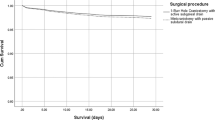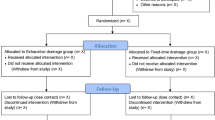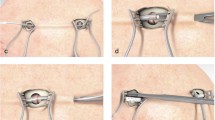Summary
Burr-hole craniotomy (BHC) and closed-system drainage undoubtedly is currently the most accepted treatment offered in chronic subdural haematoma (CSDH). Although twist-drill trephination (TDT) techniques have been available for years, now a special subdural catheter kit has been launched for treatment of CSDH. In a prospective study, 33 patients with 36 CSDH were treated with a 5-mm TDT regimen and insertion of a CORDIS subdural catheter (CORDIS Corp., Miami, USA). The results are compared with a consecutive series of 33 patients treated previously with an 11-mm BHC and closed-system drainage for 40 CSDH: Recurrence and persistence rate of CSDH treated with TDT necessitating a second intervention was 18.1%, no further surgical intervention was necessary. In BHC treated patients, 33.3% of haematomas had to be reoperated on, another 6.0% had to be re-operated on a third time. Infection rate in BHC treated patients was 18.1% as compared with a 0% infection rate in patients treated with the TDT technique. Mortality rate for the BHC method was 9.0% as compared with 6.0% in the TDT treatment regimen.
Significantly better clinical results are achieved using the TDT technique with insertion of a special subdural catheter, making this procedure superior to the BHC regimen.
Similar content being viewed by others

References
Aoki N (1992) A new therapeutic method for chronic subdural haematoma in adults: replacement of the haematoma with oxygen via percutaneous subdural tapping. Surg Neurol 38: 253–256
Aoki N, Sakai T (1993) Computed tomography features immediately after replacement of haematoma with oxygen through percutaneous subdural tapping for the treatment of chronic subdural haematoma in adults. Acta Neurochir (Wien) 120: 44–46
Benzel EG, Bridges RM Jr, Hadden TA, Orrison WW (1994) The single burr hole technique for the evacuation of non-acute subdural haematomas. J Trauma 36: 190–194
Choudhury AR (1994) Avoidable factors that contribute to complications in the surgical treatment of chronic subdural haematoma. Acta Neurochir (Wien) 129: 15–19
Grisoli F, Graziani N, Veragut C, Vincentelli F, Fabrizi AP, Caruso G, Bellard S (1988) Perioperative lumbar injection of Ringer's lactate solution in chronic subdural haematomas: a series of 100 cases. Neurosurgery 23, 5: 616–621
Hamilton MG, Frizzell JB, Tranmer BI (1993) Chronic subdural haematoma: the role for craniotomy reevaluated. Neurosurgery 33: 67–72
Harders A, Eggert HR, Weigel K (1982) Behandlung des chronischen Subduralhämatoms mit externer geschlossener Drainage. Bericht über 100 konsekutive Fälle. Neurochirurgia 25: 147–152
Horwitz NH (1993) Comment to: Hamilton MG,et al. Neurosurgery 33: 72
Hubschmann OR (1980) Twist drill craniotomy in the treatment of chronic and subacute subdural haematomas in severely ill and elderly patients. Neurosurgery 6: 233–236
Ito H, Komai T, Yamamoto S (1975) Fibrin and fibrinogen degradation products in chronic subdural hematoma. Neurol Med Chir 15 (Tokyo) 51–55
Kawakami Y, Chikama M, Tamiya T, Shimamura Y (1989) Coagulation and fibrinolysis in chronic subdural hematoma. Neurosurgery 25: 25–29
Markwalder TM, Steinsiepe KF, Rohner M, Reichenbach W, Markwalder H (1981) The course of chronic subdural haematomas after burr-hole craniotomy and closed-system drainage. J Neurosurg 55: 390–396
Markwalder TM, Seiler RW (1985) Chronic subdural haematomas: to drain or not to drain? Neurosurgery 16: 185–188
Ram Z, Hadani M, Sahar A, Spiegelmann R (1993) Continuous irrigation drainage of the subdural space for the treatment of chronic subdural haematoma. A prospective clinical trial. Acta Neurochir (Wien) 120: 40–43
Smely C, Madlinger A, Scheremet R: Prospective comparison of coagulation and fibrinolysis parameters during treatment of chronic subdural haematoma with different treatment protocols, (in preparation)
Tabaddor K, Shulman K (1977) Definite treatment of chronic subdural haematoma by twist-drill craniotomy and closed-system drainage. J Neurosurg 46: 220–226
Tator CH (1993) Comment to: Hamilton MGet al. Neurosurgery 33: 72
Wakai S, Hashimoto K, Watanabe N, Inoh S, Ochiai C, Nagai M (1990) Efficacy of closed-system drainage in treating chronic subdural haematoma: a prospective comparative study. Neurosurgery 26: 771–773
Weisse A, Berney J (1994) Chronic subdural haematomas. Results of a closed drainage method in adults. Acta Neurochir (Wien) 127: 37–40
Author information
Authors and Affiliations
Rights and permissions
About this article
Cite this article
Smely, C., Madlinger, A. & Scheremet, R. Chronic subdural haematoma — a comparison of two different treatment modalities. Acta neurochir 139, 818–826 (1997). https://doi.org/10.1007/BF01411399
Issue Date:
DOI: https://doi.org/10.1007/BF01411399



